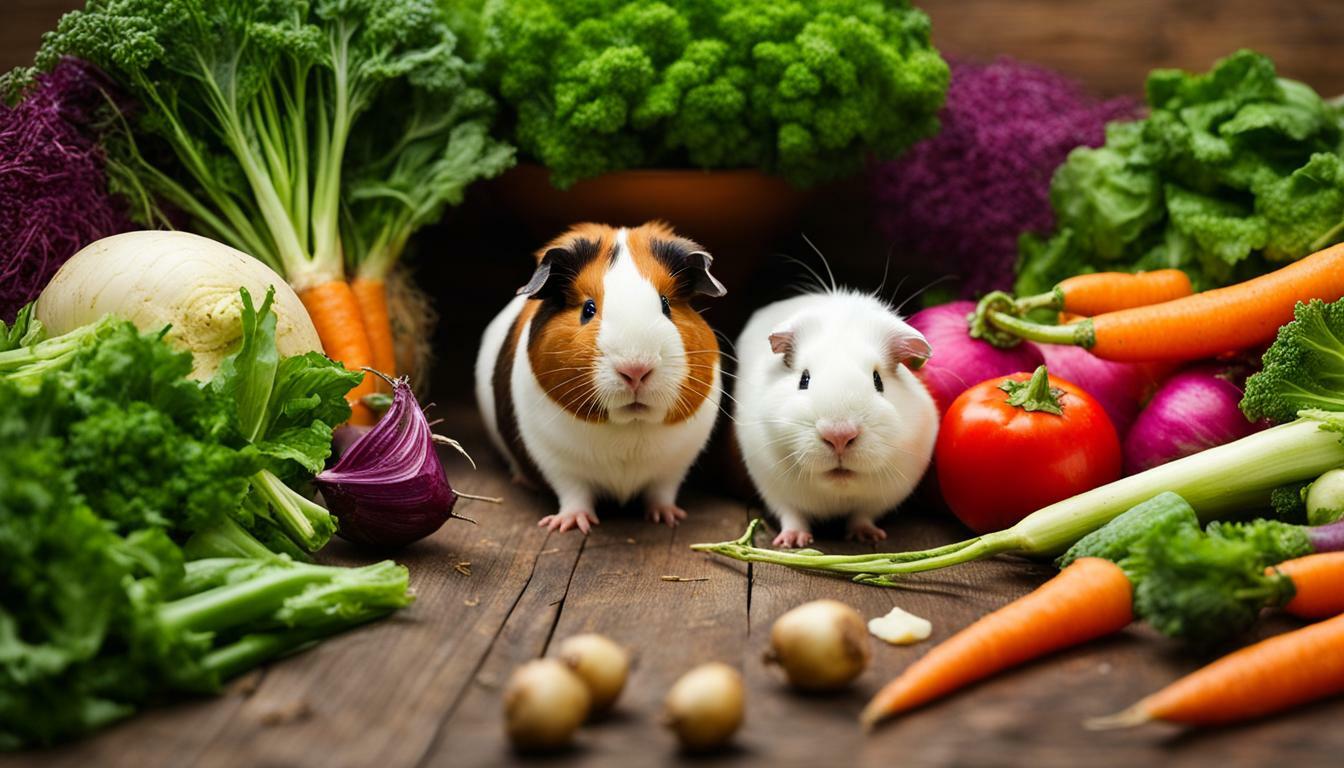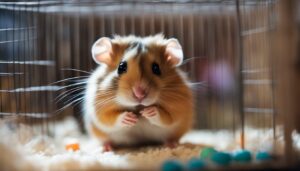Guinea pigs can eat turnips in moderation as an occasional treat while considering their specific dietary requirements. Turnips are rich in vitamins C, K, and folate, and provide health benefits for guinea pigs. However, they should be fed sparingly due to their high calcium content, which can lead to bladder stones. Turnip greens are especially high in calcium and should be fed in moderation. Turnips should be introduced gradually to prevent digestive upset and washed thoroughly before serving. It is important to maintain a balanced diet for guinea pigs and offer a variety of fresh vegetables along with hay and high-quality pellets. Monitoring for any digestive issues is important, and consulting a veterinarian for personalized feeding recommendations is recommended. Other safe vegetables to include in a guinea pig’s diet include kohlrabi, cilantro, and fresh grass.
Key Takeaways:
- Turnips can be fed to guinea pigs in moderation as an occasional treat.
- They are a good source of vitamins C, K, and folate.
- High calcium content in turnips and turnip greens should be considered, as it can lead to bladder stones.
- Introduce turnips gradually to prevent digestive issues.
- Wash turnips thoroughly before serving to ensure cleanliness.
- Maintain a balanced diet for guinea pigs, including hay, pellets, and a variety of fresh vegetables.
- Monitor for any digestive issues and seek personalized feeding recommendations from a veterinarian.
Understanding Guinea Pig Diet
A healthy guinea pig diet includes a variety of fresh vegetables, along with hay and high-quality pellets, to ensure they receive the necessary nutrients. Guinea pigs are herbivores, and their digestive systems are specifically adapted to process a high-fiber diet. Vegetables play a crucial role in providing essential vitamins and minerals for their overall health and well-being.
When it comes to choosing vegetables for guinea pigs, it’s important to select options that are safe and beneficial. Leafy greens such as romaine lettuce, spinach, and kale are excellent choices as they are packed with nutrients like vitamin C and calcium. Other suitable options include bell peppers, carrots, and cucumbers.
In addition to vegetables, hay should make up the bulk of a guinea pig’s diet. It provides the necessary fiber for proper digestion and helps keep their teeth healthy. High-quality guinea pig pellets can also supplement their diet, ensuring they receive vital nutrients like vitamin C, which is not produced naturally by their bodies.
| Safe Vegetables for Guinea Pigs: |
|---|
| Romaine lettuce |
| Spinach |
| Kale |
| Bell peppers |
| Carrots |
| Cucumbers |
To ensure your guinea pig receives a balanced diet, it’s essential to provide a variety of vegetables, rotating them regularly to provide different nutrients. Introduce new foods gradually, monitoring for any signs of digestive upset. If you notice any adverse reactions, consult with a veterinarian for personalized feeding recommendations.
Nutritional Value of Turnips for Guinea Pigs
Turnips offer a range of essential nutrients, such as vitamins C, K, and folate, making them a potentially beneficial addition to a guinea pig’s diet. These vitamins play a crucial role in supporting the overall health and immune system of guinea pigs, promoting healthy growth and development. Additionally, turnips are low in calories and fat, making them a healthy option for maintaining a guinea pig’s weight.
Along with vitamins, turnips also provide dietary fiber, which aids in digestion and contributes to healthy bowel movements. Fiber is an essential component of a guinea pig’s diet, as it helps prevent digestive issues such as bloating and constipation. Including turnips in moderation can help ensure a well-rounded and nutritionally balanced diet for your furry friend.
It is worth noting that while turnips themselves are nutritious, the greens of the plant, which are often attached, contain a significant amount of calcium. High calcium content can pose a risk to guinea pigs and contribute to bladder stones. Therefore, it is essential to offer turnips sparingly and limit the consumption of the leafy greens, focusing on the root portion instead.
| Nutrient | Amount per 100g of Turnips |
|---|---|
| Vitamin C | 21mg |
| Vitamin K | 0.3μg |
| Folate | 17μg |
| Calcium | 30mg |
| Calories | 28 |
| Fat | 0.1g |
When introducing turnips to your guinea pig’s diet, do so gradually to allow their digestive system to adjust. Start with small amounts and observe their response. If there are no signs of digestive upset, you can continue to offer turnips as an occasional treat alongside a variety of fresh vegetables, hay, and high-quality pellets. Remember to always wash turnips thoroughly, removing any dirt or pesticides, to ensure the safety and well-being of your furry companion.
As with any changes to a guinea pig’s diet, it is important to monitor their overall health and consult a veterinarian for personalized feeding recommendations. They can provide guidance based on your guinea pig’s individual needs and help ensure a balanced and nutritious diet for optimal well-being.
Caution with Calcium Content
While turnips have nutritional benefits, their high calcium content requires caution when feeding them to guinea pigs to prevent potential bladder stone problems. Guinea pigs are prone to developing bladder stones, which can be painful and lead to urinary tract issues. The excess calcium found in turnips, especially in the greens, can contribute to the formation of these stones.
To minimize the risk, it is important to offer turnips as an occasional treat and in moderation. The recommended serving size for turnips is about one to two small pieces, once or twice a week. By limiting the intake of turnips, you can help maintain a balanced diet that meets the nutritional needs of your guinea pig without overwhelming their system with excessive calcium.
| Calcium Content in Turnip Greens (per 100g) | Calcium Content in Turnips (per 100g) |
|---|---|
| 190mg | 30mg |
While turnips can provide essential vitamins C, K, and folate, it is important to offer a variety of other safe vegetables to ensure a well-rounded diet for your guinea pig. Some examples include kohlrabi, cilantro, and fresh grass. Hay and high-quality pellets should also be a significant part of their daily intake for proper nutrition.
Monitoring your guinea pig’s digestion is crucial when introducing any new food, including turnips, into their diet. Look out for any signs of discomfort, such as a decrease in appetite, changes in bowel movements, or bloating. If you notice any digestive issues or have concerns about your guinea pig’s diet, it is always best to consult with a veterinarian for personalized feeding recommendations.
Introducing Turnips Gradually
To prevent digestive upset, it is important to introduce turnips gradually into your guinea pig’s diet, observing their reactions and adjusting accordingly. Guinea pigs have sensitive digestive systems, and sudden changes in their diet can lead to stomach issues. Start by offering a small piece of turnip as a treat and monitor your guinea pig’s response.
If your guinea pig shows no signs of distress or digestive upset, you can gradually increase the amount of turnip given over time. Keep in mind that turnips should only make up a small portion of their overall vegetable intake, as a well-balanced diet is essential for their health.
When adding turnips to your guinea pig’s diet, it is recommended to diversify their vegetable choices. Offer a variety of fresh vegetables, such as leafy greens and other safe options like kohlrabi, cilantro, and fresh grass. This variety ensures that your guinea pig receives a wide range of nutrients.
| Safe Vegetables for Guinea Pigs | Nutritional Benefits |
|---|---|
| Kohlrabi | Rich in dietary fiber and vitamin C |
| Cilantro | Contains antioxidants and essential vitamins |
| Fresh Grass | Aids digestion and provides essential nutrients |
Remember to wash turnips thoroughly before serving to remove any dirt or pesticides that may be present on the skin. Clean, fresh vegetables are crucial for your guinea pig’s well-being. Additionally, it is important to monitor your guinea pig’s diet for any signs of digestive issues or discomfort. If you notice any problems, consult a veterinarian for personalized feeding recommendations.
Preparing Turnips for Feeding
Before serving turnips to your guinea pigs, it is crucial to wash them thoroughly to eliminate any potential dirt or harmful substances. Start by rinsing the turnips under cool running water, using a scrub brush or vegetable brush to gently scrub away any visible dirt or debris. This will help ensure that your guinea pigs are not exposed to any harmful pesticides or contaminants that may be present on the skin of the turnips.
Once the turnips are cleaned, you can proceed to remove the tops (greens) and the ends of the turnips. It is important to note that turnip greens should be fed in moderation due to their high calcium content. Instead, focus on feeding the turnip bulbs to your guinea pigs. Cut the bulbs into small, bite-sized pieces that are easy for your guinea pigs to chew and digest.
When serving turnips to your guinea pigs, it is recommended to offer them in combination with a variety of other vegetables to ensure a balanced diet. Guinea pigs require a mixture of fresh vegetables, hay, and high-quality pellets for optimal nutrition. Remember to monitor your guinea pigs’ digestive health closely after introducing turnips or any new food into their diet.
| Safe Vegetables for Guinea Pigs | Nutritional Benefits |
|---|---|
| Kohlrabi | Rich in vitamin C and fiber |
| Cilantro | Provides vitamin C, calcium, and antioxidants |
| Fresh Grass | Natural source of fiber and supports dental health |
Aside from turnips, other safe vegetables that you can include in your guinea pig’s diet are kohlrabi, cilantro, and fresh grass. Kohlrabi is packed with vitamin C and fiber, while cilantro provides vitamin C, calcium, and antioxidants. Fresh grass is a natural source of fiber, which aids in digestion and also supports dental health for your guinea pigs.
Remember, it is important to consult with a veterinarian for personalized feeding recommendations for your guinea pigs. Every guinea pig is unique, and their dietary needs may vary based on factors such as age, weight, and overall health. By offering a variety of fresh vegetables, monitoring their digestion, and seeking professional advice, you can ensure that your guinea pigs stay healthy and happy.
Disclaimer: The information provided in this article is for educational purposes only and should not be considered as veterinary advice. If you have any concerns about your guinea pigs’ diet or health, please consult with a qualified veterinarian.
| Vegetable | Nutritional Benefits |
|---|---|
| Turnips | Rich in vitamins C, K, and folate |
| Kohlrabi | High in vitamin C and fiber |
| Cilantro | Provides vitamin C, calcium, and antioxidants |
| Fresh Grass | Natural source of fiber, aids digestion, and supports dental health |
Additional Safe Vegetables for Guinea Pigs
In addition to turnips, other safe vegetables such as kohlrabi, cilantro, and fresh grass can be included in a guinea pig’s diet to provide a diverse range of nutrients. These vegetables offer various vitamins and minerals that contribute to the overall health and well-being of guinea pigs.
Kohlrabi is a cruciferous vegetable that is low in calories and high in fiber. It is rich in vitamin C, which is essential for guinea pigs as they cannot produce it on their own. Kohlrabi also provides potassium, vitamin B6, and antioxidants that support immune function.
Cilantro, also known as coriander leaves, is a flavorful herb that can be enjoyed by guinea pigs. It is a good source of vitamin K, which plays a role in blood clotting, and it also contains antioxidants that help protect against cell damage. Cilantro adds variety to their diet and can be fed in small amounts as part of a balanced meal.
Fresh grass is a natural food choice for guinea pigs as it mimics their wild diet. Grass is rich in fiber and helps promote healthy digestion. Providing fresh grass, either through supervised outdoor access or carefully selected and washed grass from a trusted source, allows guinea pigs to enjoy a more natural and varied diet.
| Vegetable | Nutrients | Benefits |
|---|---|---|
| Kohlrabi | Vitamin C, potassium, vitamin B6, antioxidants | Supports immune function and provides essential vitamins |
| Cilantro | Vitamin K, antioxidants | Contributes to blood clotting and protects against cell damage |
| Fresh grass | Fiber | Promotes healthy digestion and adds variety to the diet |
Importance of Monitoring and Veterinary Consultation
Regular monitoring of your guinea pig’s diet and consulting with a veterinarian for personalized recommendations are crucial for maintaining their overall health and well-being. While turnips can be a nutritious addition to their diet, it is important to exercise caution due to their high calcium content. Bladder stone formation can be a potential risk, especially when turnips or turnip greens are fed excessively.
To ensure a smooth transition and minimize digestive issues, it is recommended to introduce turnips gradually. Start by offering small amounts and observe how your guinea pig responds. If any signs of discomfort or digestive upset are noticed, it is advised to discontinue feeding turnips and consult with a veterinarian for further guidance.
In addition to turnips, it is essential to provide a balanced diet for your guinea pig. Offer a variety of fresh vegetables, such as kohlrabi and cilantro, along with a constant supply of hay and high-quality pellets. This ensures they receive all the necessary nutrients for optimal health.
| Veggies for Guinea Pigs | Benefits |
|---|---|
| Turnips | Rich in vitamins C, K, and folate |
| Kohlrabi | High in fiber and vitamin C |
| Cilantro | Contains antioxidants and promotes digestion |
| Fresh Grass | Natural source of vitamins and minerals |
Remember, each guinea pig is unique, and their dietary needs may vary. Regular veterinary check-ups are essential to assess their overall health and receive personalized recommendations. A veterinarian can provide guidance on the frequency and quantity of turnips or other vegetables suitable for your guinea pig’s specific needs.
Conclusion
When it comes to feeding turnips to guinea pigs, moderation, attention to their specific dietary requirements, and veterinary guidance play crucial roles in ensuring a healthy and balanced diet for these adorable pets.
Guinea pigs can enjoy turnips as an occasional treat due to their rich nutritional profile. Turnips are packed with vitamins C, K, and folate, which are beneficial for guinea pigs’ overall health. However, their high calcium content should be taken into consideration.
High levels of calcium can lead to bladder stone formation in guinea pigs, so it’s essential to offer turnips sparingly. Turnip greens, in particular, should be fed in moderation due to their elevated calcium content. Gradually introducing turnips into their diet can help prevent any potential digestive upset.
In addition to turnips, it’s crucial to provide a well-balanced diet for guinea pigs. This includes offering a variety of fresh vegetables, along with their staple diet of hay and high-quality pellets. Monitoring their diet for any digestive issues and seeking personalized feeding recommendations from a veterinarian are essential for their well-being.
Other safe vegetables that can complement a guinea pig’s diet include kohlrabi, cilantro, and fresh grass. These vegetables offer additional nutrients and variety to their meals, ensuring a well-rounded and enjoyable dining experience for our furry friends.
FAQ
Can guinea pigs eat turnips?
Yes, guinea pigs can eat turnips in moderation as an occasional treat.
What are the nutritional benefits of turnips for guinea pigs?
Turnips are rich in vitamins C, K, and folate, which provide health benefits for guinea pigs.
Why should turnips be fed sparingly?
Turnips should be fed sparingly due to their high calcium content, which can lead to bladder stones in guinea pigs.
How should turnips be introduced to a guinea pig’s diet?
Turnips should be introduced gradually to prevent digestive upset and to monitor for any adverse reactions.
Should turnip greens be fed to guinea pigs?
Turnip greens, being high in calcium, should be fed in moderation to guinea pigs.
How should turnips be prepared before feeding them to guinea pigs?
Turnips should be thoroughly washed to remove any dirt or pesticides before serving them to guinea pigs.
What other vegetables are safe for guinea pigs to eat?
Other safe vegetables for guinea pigs include kohlrabi, cilantro, and fresh grass.
Why is monitoring a guinea pig’s diet important?
Monitoring a guinea pig’s diet is important to ensure their well-being and to identify any potential digestive issues.
Should I consult a veterinarian for personalized feeding recommendations?
Yes, it is recommended to consult a veterinarian for personalized feeding recommendations for your guinea pig to ensure their optimal health and nutrition.




